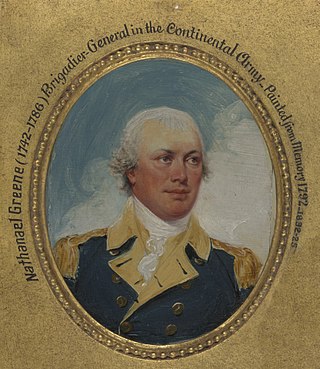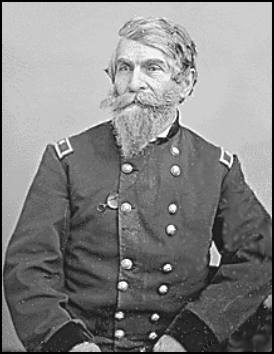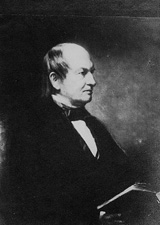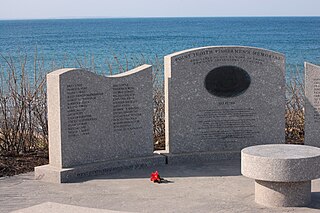See also
- Fort Green, a fort in Florida
- Fort Greene Ville, formerly a fort in Ohio and now a renamed city
Fort Greene is a neighborhood in Brooklyn, New York.
Fort Greene may also refer to:

Brooklyn is a borough of New York City located at the westernmost end of Long Island in the State of New York. Formerly an independent city, the borough is coextensive with Kings County, one of twelve original counties established under British rule in 1683 in the then Province of New York. As of the 2020 United States census, the population stood at 2,736,074, making it the most populous of the five boroughs of New York City, the most populous county in the state. Brooklyn, at 37,339.9 inhabitants per square mile (14,417.0/km2), is the second most densely populated county in the U.S. after Manhattan, as of 2022. Had Brooklyn remained an independent city, it would today be the fourth most populous American city after the rest of New York City, Los Angeles, and Chicago.

The Battle of Long Island, also known as the Battle of Brooklyn and the Battle of Brooklyn Heights, was an action of the American Revolutionary War fought on August 27, 1776, at and near the western edge of Long Island in present-day Brooklyn. The British defeated the Continental Army and gained access to the strategically important Port of New York, which they held for the rest of the war. It was the first major battle to take place after the United States declared its independence on July 4, 1776, in Philadelphia. It was the largest battle of the Revolutionary War in terms of both troop deployment and combat.

Major-General Nathanael Greene was an American military officer and planter who served in the Continental Army during the Revolutionary War. He emerged from the war with a reputation as one of George Washington's most talented and dependable officers and is known for his successful command in the Southern theater of the conflict.

Fort Greene is a neighborhood in the northwestern part of the New York City borough of Brooklyn. The neighborhood is bounded by Flushing Avenue and the Brooklyn Navy Yard to the north, Flatbush Avenue Extension and Downtown Brooklyn to the west, Atlantic Avenue and Prospect Heights to the south, and Vanderbilt Avenue and Clinton Hill to the east. The Fort Greene Historic District is listed on the New York State Registry and on the National Register of Historic Places, and is a New York City designated historic district.

Fort Greene Park is a city-owned and -operated park in Fort Greene, Brooklyn. The 30.2-acre (12.2 ha) park was originally named after the fort formerly located there, Fort Putnam, itself was named for Rufus Putnam, George Washington's chief of engineers in the Revolutionary War.

George Sears Greene was a civil engineer and a Union general during the American Civil War. He was part of the Greene family of Rhode Island, which had a record of distinguished military service to the United States. He first served in the Army from 1823 to 1836 after graduating second from his class at West Point. As a civilian, he was one of the founders of the American Society of Civil Engineers and Architects and was responsible for numerous railroads and aqueduct construction projects in the northeastern United States.
Washington Park may refer to the following, all in the United States:

Fort Adams is a former United States Army post in Newport, Rhode Island, that was established on July 4, 1799, as a First System coastal fortification, named for President John Adams, who was in office at the time. Its first commanding officer was Captain John Henry who was later instrumental in starting the War of 1812. The current Fort Adams was built between 1824 and 1857 under the Third System of coastal forts; it is part of Fort Adams State Park today.

The 1st Rhode Island Regiment was a regiment in the Continental Army raised in Rhode Island during the American Revolutionary War (1775–83). It was one of the few units in the Continental Army to serve through the entire war, from the siege of Boston to the disbanding of the Continental Army on November 3, 1783.
Ken(ny) or Kenneth Green(e) may refer to:

The state of Rhode Island during the American Civil War remained loyal to the Union, as did the other states of New England. Rhode Island furnished 25,236 fighting men to the Union Army, of which 1,685 died. The state used its industrial capacity to supply the Union Army with the materials needed to win the war. Rhode Island's continued growth and modernization led to the creation of an urban mass transit system and improved health and sanitation programs.

Christopher Greene was an American legislator and soldier. He led the spirited defense of Fort Mercer in the 1777 Battle of Red Bank, and for leading the African American 1st Rhode Island Regiment during the American Revolutionary War, most notably with distinction in the 1778 Battle of Rhode Island. He was killed in May 1781 at the Battle of Pine's Bridge by Loyalists, possibly because he was known to lead African American troops.

Albert Collins Greene was an American lawyer and politician from Rhode Island. He served as a United States senator and Attorney General of Rhode Island.

Fishermen's Memorial State Park is a public recreation area and campground encompassing 91 acres (37 ha) on Point Judith in the town of Narragansett, Rhode Island. The state park occupies a portion of the former Fort Nathaniel Greene, named after Rhode Island native and Revolutionary War general Nathaniel Greene.

Laurie A. Cumbo is an American politician and Commissioner of the New York City Department of Cultural Affairs. A Democrat, she served in the New York City Council for the 35th district from 2014 to 2021, which includes the Brooklyn neighborhoods of Fort Greene, Clinton Hill, and Prospect Heights, portions of Bedford-Stuyvesant, Crown Heights, Downtown Brooklyn, the Brooklyn Navy Yard, and Vinegar Hill. She is the founder and first executive director of the Museum of Contemporary African Diaspora Arts.
The 243rd Coast Artillery Regiment was a Coast Artillery Corps regiment in the Rhode Island National Guard. It garrisoned the Harbor Defenses of Narragansett Bay, Rhode Island 1924–1944.
Joseph Sprague was an American businessman and politician who served as Mayor of Brooklyn.
Samuel Smith was an American politician and Mayor of Brooklyn.